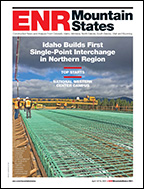The vast majority of the bridges concerned are replaced in-line, in that they are being replaced in exactly the same location as the existing structure. New piers are built within the live corridor around train movements over several months—depending on the number and depth of the new piers—during a 'block of line' where there are no train movements at all. This operation is usually a 24 to 48 hour operation in which the old bridge is taken out, the new bridge deck is lifted in or assembled and the track reinstated.
Bridge 72 on the Midland Line is a typical span replacement in the project, where Smith Crane and Construction (SCC) has installed two 14-m concrete ballast deck spans on new concrete piers and abutments. All works prior to the actual bridge replacement had to be carried out in the live railway corridor in between trains. The bridge replacement was completed within a 36 hours window.
Clive Baddeley, civil engineering manager at SCC, says the project at Camp Creek marked the end of a successful five-month operation in bad weather. Civil work involved the construction piers and crossbeams to support the new decks. “Temporary works involved the design and fabrication of a specialised falsework system to support the headstock soffit,” he said.
“After column curing, the headstock soffits were bolted to either side of the columns, and propped from below. The handrails were pre-attached to provide a safe platform. A pre-tied cage was then lifted onto the soffit, and steel forms bolted on. After that, the inserts were accurately placed between the bars and their location double checked and made secure.” Then came the casting of the headstocks themselves.
“The precast deck units were manufactured on site, as we had previously done on bridges 41 and 61 on the Midland Line. A series of concrete pads was cast for the steel deck mould to sit on. After each cast, the unit was lifted and the mould moved to the next cast location—reinforcement, stressing ducts and cast-in items were fixed in the mould.” 65-MPa concrete, sourced from Allied Concrete in Timaru, was placed in the early morning to allow sufficient curing time.
Once adequately cured, the deck unit was jacked out of the mould and the latter pulled out for the next cast and for cables to be inserted, tensioned and locked off.
A tandem lift plan for the 115-tonne precast deck units was used on the project, whereby each unit was transported for final placement by 220 tonne and 300 tonne mobile cranes onto the available headstocks.



Post a comment to this article
Report Abusive Comment